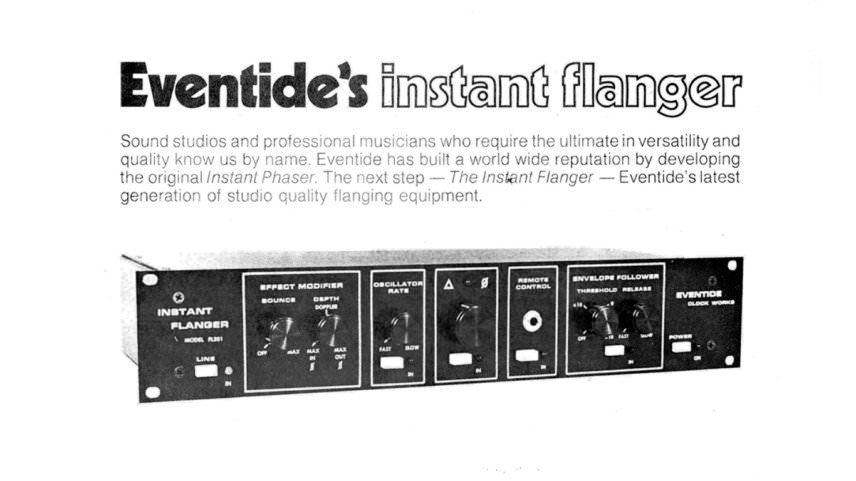Hasn’t flanging moved on since the 70s? James Russell loads up the second official virtual recreation of this iconic hardware box to ask if it’s a timeless classic or a flanachronism.
The ‘Instant’ in the title might confuse some – these days, every flanger plugin will give you that slow jet-plane whoosh the second you load it up. This plugin, however, is the second virtual recreation of Eventide’s 70s rack unit of the same name. The FL201 Instant Flanger was the first solution to flanging that didn’t rely on playing audio through two tape decks and moving one slowly in and out of time with the other.
Instead, the DL201 used bucket-brigade delay chips to create its delayed signal. This purely electrical take on flanging was supplemented by a few controls for pushing the tone into territories that were radical at the time.

Too much of a history lesson? Put simply, if flanging of a particularly vintage tone is what you want, this plugin will appeal, especially given the £1000+ price tag of the original unit.
There’s a lot you can do with Instant Flanger Mk II, especially compared to the original ‘Mk I’ version, but with this plugin’s attitude being firmly rooted in the past, you’ll have to invest time in learning how to use it if you want to get results. This isn’t a 21st-century UX-driven effect – this is the audio version of a designer label.
Three Ways to Flange
There are actually three ways to control Instant Flanger Mk II, which can be activated individually or in combination. The first is the unmarked largest knob, which offers manual control over the virtual bucket brigade chip timings. It’s a good target for DAW automation, or just a ‘set-and-forget’ control.
On the the left of the main manual control, you can choose to engage the LFO for typical, traditional flanging styles. This has a frequency between 0.01Hz and 20Hz. This can also be locked to host tempo and manually retriggered in the bottom panel. Using the left-most Bounce control, you can simulate the mechanical servo of a tape deck catching up with, overshooting, and going back to its intended course when the delay time is changed.
This isn’t a 21st-century UX-driven effect – this is the audio version of a designer label.
Finally, the Envelope Follower module acts to trigger flanging only when your input signal crosses a certain threshold. This can be an interesting aid for adding life to crash cymbals and other high-end transients. An even more versatile addition for this plugin version would have been an invert switch for this operation. This parameter can also take a Sidechain signal to have its Threshold tickled by external audio, and ‘Remote’ input for MIDI mod wheel control.
Leaving on a Jet Plane
Feedback sends the delayed signal back through to its input, resulting in a deeper effect when pushed up, and all-out oscillation when pushed to its extremes. In effect, Feedback encourages that classic ‘jet plane’ flanging effect, giving things an artificial whoosh by emphasising the comb filtering happening to the signal – this is secretly the essence of ‘that’ flanging sound. The feedback can also be inverted to change the response.

The bipolar Depth (Doppler) control isn’t a primary parameter as you’d expect from using modern flangers. When this is in the middle at 0%, you hear only the delayed signal; Push it up to blend the original and the delayed signal in phase, and push it down to blend the two out of phase. The result, in practical terms, is a bassier response when things are in phase, and a sort of low-cut-flange when things are out of phase.
UI nerd point: for Mk II, this control in particular now resets to +100% not -100% when double-clicked, although 0% might seem more logical. While it’s still hard to set it to 0% my moving the knob, you can enter exact values with the keyboard.
Fringe Flange Opinions
You couldn’t expect a company with a reputation such as Eventide’s to fully leave the past behind, although they have been seen stepping into the future with plugin-only ideas like the ‘Structural Effects’ of Physion. With a name that’s appeared in most high-end studios for decades, it would probably be silly for them to ignore their history.
It’s this backward-looking that’s had me on the lookout for reasons not to like Instant Flanger Mk II, with its unintuitive control set and fixed choice of applications. The legacy ‘Mk I’ plugin version left plenty to be desired, but fortunately, almost every shortcoming of Mk I has been addressed in Mk II.
Despite going into this cynically, though, I haven’t found any excuse not to enjoy this plugin. It may be something of a curio to the modern producer, but once you’ve got your head wrapped around its way of working, the amount of effects it can produce [well showcased in the library of presets including artist patches] make it interesting on any sound – even a go-to, despite the age of the technology behind it. Put simply, it’s a timeless flanger that’s still more than relevant today.
Modern digital flangers may be able to give you more innovative, earbending effects, but Instant Flanger Mk II’s analogue tone means that it doesn’t have to compete with them on that turf and certainly doesn’t claim to. This is all about emulating the classic sound of analogue flanging. As long as you’re not expecting a bells-and-whistles, showy, digital monster, you’ll be happy to have this incredibly solid tool in your plugin belt.
